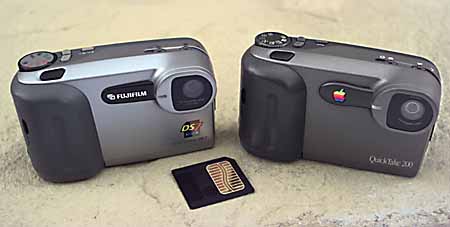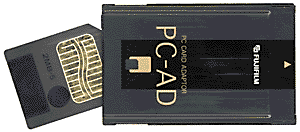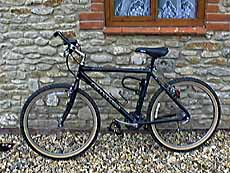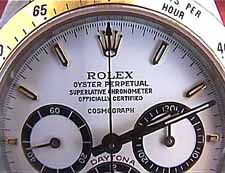
FUJI DS-7 and APPLE QUICKTAKE 200
When Fuji sent me a DS-7 camera last September, I quickly fell in love with it. I'm not the only one - it has won many awards in the last nine months. Not bad for a camera with only average image quality, no zoom, no flash, no direct vision viewfinder and which is difficult to hold steady at arm's length.
Maybe it's because this is just the right low-res digital camera to pop into your pocket, ready to capture any subject in any light, right down to macro? The colour LCD viewfinder shows exactly what the lens is viewing - just as a single lens reflex camera's 'finder does - but additionally allows captured images to be displayed immediately.
The appearance of a 'badged' version from Apple might hardly be expected to raise an eyebrow, if it were not for the fact that Apple have made a few interesting changes.

There are few clues on the Apple QuickTake 200 which lead us to its Fuji parentage. The baseplate does not tell us that the Apple camera is made by Fuji, simply that it is 'Made in Japan', but the Model number is given as 'M5709 (DS-7)' and, in both cases, the lens is a 'TV-Fujinon f=5.7mm'. Put the cameras side by side and there is no doubt. However, a closer look, especially at the pictures the cameras produce, shows us that there are subtle - but important - differences.
First, the similarities. The cameras are also tv cameras, so the viewfinder picture is 'live', being updated thirty times a second instead of the 'steppy' viewfinder pictures of so many low-res cameras. The video output is American/Japanese 525 lines NTSC, so 625 lines PAL European users can't record the output on their VHS recorders. But the chances are that your ordinary domestic tv receiver has a 'secret' NTSC decoder, as many European users of American laser discs know - because it's cheaper for the manufacturers to incorporate both, though they don't advertise the fact. This enables the cameras to be viewed in full colour.
The DS-7/QuickTake-200 does not have a shutter in the conventional sense - something mechanical which opens and closes - instead it varies the length of time during which the charge in the CCDs is allowed to build up. The cameras will take pictures in almost any light, though in low light the LCD panel is not much good as a viewfinder because the image is refreshed every thirtieth of a second. But when you press the exposure button a well exposed picture usually appears on the screen. The screen brightness can be set anywhere from black to white, so the LCD tells you almost nothing about exposure. Not that this matters - the auto exposure is good, except for heavily backlit subjects.
An LCD panel is becoming a 'must have' feature on consumer cameras but at a price - especially in battery life. On the DS-7, the LCD is the only viewfinder but Apple provide a clip-on optical finder for the QT-200, to make composition easier when the ambient light is so high that it washes out the LCD image, or when it is so low that LCD viewfinder images are very dark. It would be nice to have an on/off switch for the LCD, to save batteries, when the optical viewfinder is used.
With practice, it is quite easy to use the three-position slider to focus everywhere between about 10cm and infinity. This manual focus control causes problems with those used to autofocus compacts. It's easy to have the setting wrong - very difficult to judge focus on the 35mm contact-sized LCD, especially as your eyes get older and your arms need to hold the camera further from your body. Once you are used to it, the cameras are great for grabbing shots of new gear at trade shows. The cameras' tolerance of mixed light, carrying out automatic white balance on the fly, is also useful for this kind of use.
There are two -stops, 2.2 and 8, and the camera even tells you when it needs the other aperture but it does not stop you taking pictures on the other setting, if you feel you know better.
 The Toshiba designed SmartMedia SSFDC (Solid State
Floppy Disk Card) image memory card is rapidly becoming my favourite removable
media. It is not much bigger than a piece of 35mm film, 37x45x0.75mm thick
- 1.75x1.56x0.03 inches. One of the worries was that this media would be
fragile and susceptible to damage by static electricity but, in nine months
of using the DS-7 and constantly changing over cards, I have never experienced
any problem. On the contrary, the card is very easy to insert into the camera
- once you have learned that the angled corner goes at the top.
The Toshiba designed SmartMedia SSFDC (Solid State
Floppy Disk Card) image memory card is rapidly becoming my favourite removable
media. It is not much bigger than a piece of 35mm film, 37x45x0.75mm thick
- 1.75x1.56x0.03 inches. One of the worries was that this media would be
fragile and susceptible to damage by static electricity but, in nine months
of using the DS-7 and constantly changing over cards, I have never experienced
any problem. On the contrary, the card is very easy to insert into the camera
- once you have learned that the angled corner goes at the top.
One of the very biggest 'pluses' for me is that the SmartMedia card slots into a PC card adaptor, which in turn slots into the PC card slot on my laptop. This means that I do not have to mess around with serial cables, noted for their sloth and frequent communication problems between camera and computer. Since the camera images are saved as standard PC format PICT JPEGs, I can open them directly from Adobe Photoshop without the unnecessary additional encumbrance of camera-specific acquisition software. This is an important convenience which brings me back to the DS-7/QT-200 time and time again.
With so many similarities, you might well wonder what - if any - differences there are. On the exterior of the cameras there is not much difference, apart from a different colour scheme and badge. Inside, there are some significant changes to the image processing in the (later) Apple model.
The Fuji DS-7 has two image capture settings. One JPEG compresses 640x480 pixel images from 900KB to about 63KB - just 7% of its former size. The other setting 'ECO' compresses 320x240 pixel quarter-resolution images from 226KB to about 32KB - down to 14%. These images are such low resolution that they are unlikely to be of interest to you.
The Apple QuickTake-200 also has two image capture settings but they have done away with the 320x240 setting and substituted a 640x480 setting with a lower compression (fine) setting. On the fine setting, the 900KB 640x480KB image is compressed to about 86KB (9.6%), on the normal setting the image is compressed to about 63KB - the same as in the DS-7 - or 7%. A 2MB SmartMedia image memory card holds 30 images saved at the normal setting, 22 at the fine setting.
So how do the pictures look? There is a noticeable difference between the pictures produced by the DS-7 and the QuickTake-200. The difference between the two compression ratios of the QT-200 is almost indiscernible, except at such high magnifications that the pixels would be very noticeable anyway. But the QT-200 is noticeably sharper than its Fuji parent, even at the same compression ratio.

Above: This image was taken on the QuickTake 200 at the 'Fine' setting.



Detail - Left: QuickTake 200 at 'Normal' setting. Centre: QuickTake 200 at 'Fine' setting. Right: Fuji DS-7.
I mentioned that the DS-7 and QT-200 are, in effect, also video cameras. There are, of course, many other digital video cameras, which record moving images and stereo sound. These cameras are not yet fully solid state as they record their images on digital videotape.
 By
way of comparison, I captured a single frame of video from the Sony DCR-PC7E
digital camcorder by Firewire and help from German company Fast at the Montreux
International TV Symposium. This produced a 720 x 576 pixel image of a quality
much higher than the stills produced by the DS-7 and QT-200 - and most of
the plethora of other low-res digital still cameras now coming onto the
market. And the DCR-PC7E is fully featured, with 10 to 1 optical zoom, digitally
extended to 20 to 1, autofocus and an LCD screen twice as big. And of, course,
stereo sound.
By
way of comparison, I captured a single frame of video from the Sony DCR-PC7E
digital camcorder by Firewire and help from German company Fast at the Montreux
International TV Symposium. This produced a 720 x 576 pixel image of a quality
much higher than the stills produced by the DS-7 and QT-200 - and most of
the plethora of other low-res digital still cameras now coming onto the
market. And the DCR-PC7E is fully featured, with 10 to 1 optical zoom, digitally
extended to 20 to 1, autofocus and an LCD screen twice as big. And of, course,
stereo sound.
Some day the video camcorder manufacturers will take off their departmental blinkers and wake up to the fact that digital camcorders are still cameras with a fast (25fps) 'motor drive' and tape streamer attached. If that day ever comes, they could eliminate all the low-res digital still cameras - even the lovely DS-7 and QuickTake-200.
This article first appeared in "John
Henshall's Chip Shop" in "The Photographer" magazine, July/August
1997.
IMPORTANT NOTICE
This document is Copyright © 1997 John Henshall. All rights reserved.
This material may only be downloaded for personal non-commercial use. Please
safeguard the future of online publishing by respecting this copyright and
the rights of all other authors of material on the Internet.